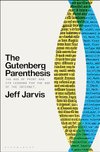The Gutenberg Parenthesis: The Age of Print and Its Lessons for the Age of the Internet
amazon.com
The Gutenberg Parenthesis: The Age of Print and Its Lessons for the Age of the Internet

Authority springs from the materiality of print as well as from the author’s name and publisher’s brand on the spine. Out of such a need for certification, these institutions were born: editor, publisher, critic, and author, in league with the university and the library.
Print, its culture and economy, gave birth to the concept of content: that writing, ideas, and creativity are commodities to fill a product, a publication, which can be sold. Print led us to the notion of creativity as asset, to the law of copyright and the doctrine of intellectual property, building a fence around the commons that was
... See moreFor half a millennium, the mediators of media—editors, publishers, producers—controlled the public conversation. Now we may break free of their gatekeeping, agendas, and scarcities—while at the same time risking the loss of the value these institutions have brought in recommending quality, certifying fact, and supporting creativity. What must we
... See moreFundamentally, this is the story of society relearning how to hold a conversation with itself.
Economically, mass media seek scale—that is, one product to serve as many people as possible; thus, deviance is expensive.
We are engaged in a ceaseless process of renegotiating our norms in a shifting reality. With more people at that negotiating table, there will be more conflict as some will demand to be heard, some will try to manipulate others, and some will claim to be canceled or censored when they may be challenged or educated. The internet thus far has been
... See moreBy definition, mass media abhor diversity. Mass media as an institution imposes one image of the public on itself, which is fashioned, God-like, in the image of those who control media. The institution rejects that which does not conform as deviant: noise.
“Embedded in the surrealistic frame of a television news show is a theory of anticommunication, featuring a type of discourse that abandons logic, reason, sequence, and rules of contradiction. In aesthetics, I believe the name given to this theory is Dadaism; in philosophy, nihilism; in psychiatry, schizophrenia. In the parlance of the theater, it
... See moreIt is necessarily elitist in description: dismissive, paternalistic, insulting, sometimes racist. The mass, said Carey, “is a metaphor for the unknowable and invisible. We cannot see the mass. Crowds can be seen; but the mass is the crowd in its metaphysical aspect—the sum of all possible crowds.… It turns other people into a conglomerate. It
... See more